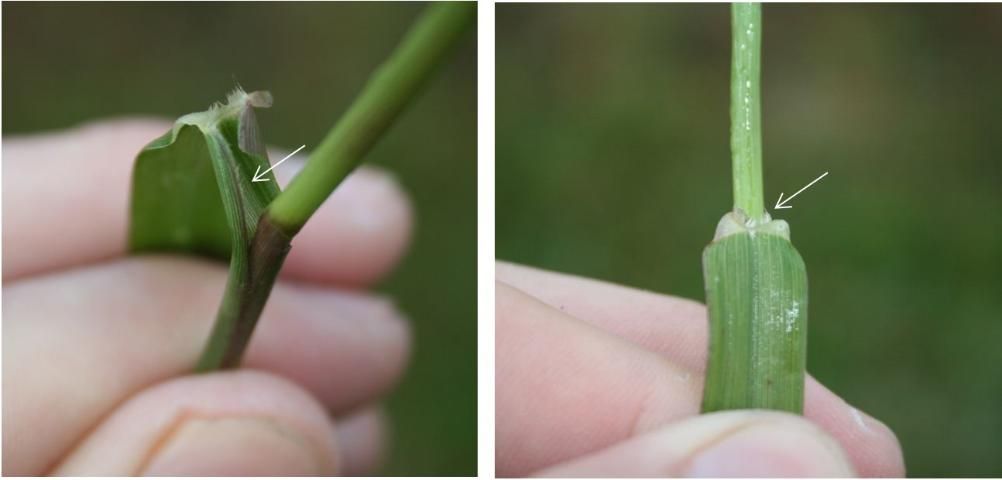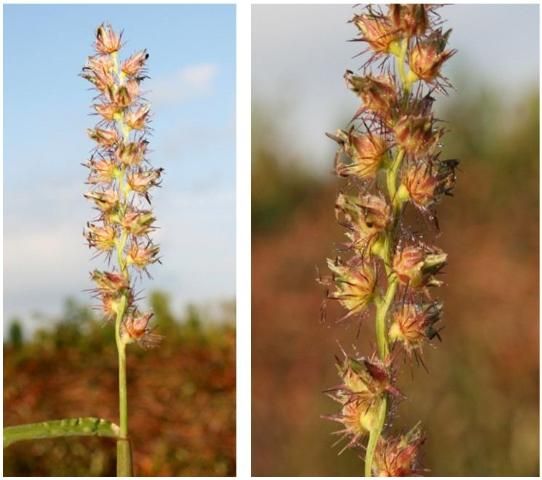
Credit: Hunter Smith, UF/IFAS
Southern sandbur is an annual grass that grows in pastures and cropland throughout the warm areas of the southern United States from Virginia to California. This native grass is adapted to dry, sandy soils and has a shallow, fibrous root system. It can easily invade a poorly managed field, diminishing the quality of a hay crop or grazing pasture. While some believe that adding lime to the hayfield will help manage sandbur, producers should sample their soil to determine if the soil pH is adequate for their particular forage. Furthermore, there is no evidence in the literature to suggest that increasing the soil pH will prevent sandbur invasion. Southern sandbur seeds start to germinate in late spring, and germination continues through the summer and fall. Flowering occurs in late fall, and growth is consistent until the first frost. However, sandbur may continue to grow through mild winters and act as a perennial species.
Identification
Sheath and Ligule
Southern sandbur has a smooth, open leaf sheath that can have fine hairs along its margin. The ligule is ciliate with a pubescent ring along the light-colored collar.

Credit: Hunter Smith, UF/IFAS
Stem and Leaf
Stems are round with a reddish tint ascending from a bent base growth habit. The leaf blades are flat with very short, thick hair on top and a smooth glabrous surface below (certain biotypes may have hairless leaves and stems). The short hair on top of the leaf blade is visible with magnification and has a sandpaper-like feel. Leaf margins can have long hair adjacent to the collar as seen in Figure 3.

Credit: Hunter Smith, UF/IFAS
Seedhead
The seedhead of southern sandbur has a raceme orientation with spiny burs attached directly to the floral stalk. Each bur contains 1–3 seeds, and they are easily dispersed when the spines attach to animals, clothing, or machinery.

Credit: Hunter Smith, UF/IFAS
Management
Pre-Emergence
Pre-emergence options for sandbur control are limited to two active ingredients, pendimethalin and indaziflam. There are two reasons that these herbicides could fail under our conditions in Florida with the first being lack of rainfall to incorporate the herbicide during the dormant season. The second reason for failure is that some of the sandbur plants in pastures and hayfields have perennated due to climatic conditions. The following two herbicides will only control plants that are germinating from seed.
Prowl H2O (pendimethalin) at 1.1–4.2 quarts per acre. Bermudagrass or bahiagrass fields should be fully established or must have been cut at least once prior to application; do not use in newly planted pastures or hayfields. Apply during winter dormancy, just prior to green up, or in-season between cuttings. Do not apply to bermudagrass or other perennial warm-season grasses after green up in spring before the first cutting. Prowl H20 may also be applied using a sequential or split-application program when the intial application is made during dormancy and the follow-up application is made in-season between cuttings. Do not apply more than 4.2 quarts per acre per year. There are no haying or grazing restrictions when using this product. This herbicide must be activated with rainfall or irrigation within two weeks of application. Not receiving activating rainfall within this time period will result in herbicide failure.
Rezilon (indaziflam) at 3 to 5 oz per acre applied during forage dormancy and before sandbur germination in the spring. For the best long-term management of sandbur in hayfields, it is best to apply split applications; 3 oz per acre during the dormant season followed by an additional 3 oz per acre after the first cutting.
Post-Emergence
Bermudagrass Only
Pastora (nicosulfuron + metsulfuron) at 1.0–1.5 ounces per acre. For best results apply to seedling sandbur. For larger plants, apply Pastora after hay removal to minimize bermudagrass response and to suppress sandbur. The addition of 8 oz/A of glyphosate will improve control more than Pastora alone when applied after hay removal. Do not apply more than 2.5 ounces of Pastora per acre per year.
Plateau/Panoramic (imazapic) at 4 ounces per acre. This treatment may suppress bermudagrass growth for 30–45 days after application. Do not use on drought-stressed bermudagrass or during transition from dormancy to green up.
Roundup Powermax II (glyphosate) at 8–11 ounces per acre. Apply immediately after hay removal, but before bermudagrass has resprouted. If sandbur is not totally controlled by the herbicide, the resprouting bermudagrass should smother it out and prevent seedhead formation. Be sure to know what glyphosate formulation is being utilized to ensure the proper application rate.
All Other Pasture Grasses
Glyphosate at 0.5% solution. Spot spray glyphosate in all areas where sandbur is present. This application will kill desirable grasses, so use caution when spraying.
Other Management Practices
Mowing is often ineffective in the control of southern sandbur. Because of sandbur's low growing habit, plants can produce seeds below the mowing height.
Grazing of southern sandbur is an option early in the season at the seedling growth stage. This may only suppress the stand because cattle will not graze on southern sandbur after flowering. Once it is flowering, the spiny burs make it an undesirable forage.